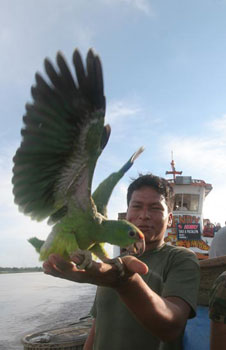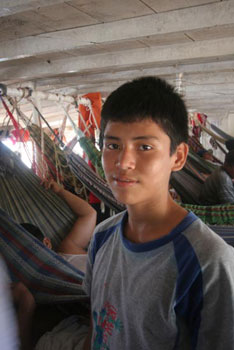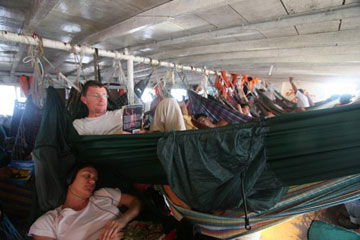Special to mongabay.com: Wilderness Classroom: Expedition 2006 The following is an update from The Wilderness Classroom’s expedition to the Peruvian rainforest. You can follow their adventures at wildernessclassroom.com |
Rivers are the highways of the Amazon
The Wilderness Classroom Organization
April 11, 2006
Update 7: Life on the launcha. – Dave
Rivers are the highways of the Amazon. Instead of driving cars and trucks, people use use boats to travel from place to place. Launchas are large boats powered by strong engines that travel up and down all the major rivers in the Amazon Basin. We have spent the last two day nights and two night on a launcha that is traveling up the Amazon River at about 10 miles an hour.
I have been on many launchas, but this is the most crowded launcha I have ever experienced. There are people, chickens, dogs, canoes, and piles of cargo everywhere. We are constantly stopping to let people and cargo off and on the boat. As soon as one person takes down their hammock, a new person springs from the shadows to hang a new hammock. In many places there are hammocks hung on top of each other to save space. There are also people sleeping on the floor, and on benches along the edge of the boat.
Last night I awoke to birds squawking near my head. Men stacked 4 crates of Macaws and Amazon Parrots a few feet from my hammock. It is illegal to harvest birds from the wild in Peru, but people do it anyway. These animals are destined to be sold in markets, like the Belen Market we visited last week. Seeing these wild animals taken from their natural environment and sold as pets is very sad.
Last week, your responses to the Daily Dilemma provided some great feedback on the illegal pet trade. Everybody commented that they thought it was wrong for animals to be taken from their families and displaced from their habitat. Mrs. Whitney’s class responded that, “If animals are removed from their natural predators, overpopulation could take place in the new environment.” Student-explorers have had very good ideas for lots of difficult issues. Keep it up!
 This young parrot was taken from its nest buy poachers and will be sold illegally. Several crates of young parrots were loaded onto the launcha one night while we slept. |
The launcha is full of new sights, smells, and sounds, but we are ready to leave the launcha and begin our journey by canoe.
The seasonal floods have come to the Amazon, and many of the villages we pass are flooded. During the high water season it is hard for the launchas to go up-stream against the river’s strong current. A trip that takes 2 days when the water is low will take 3 or 4 days because of the strong currents caused by the rising water.
However a slower trip is a small sacrifice. When the river floods, it brings nutrients into people’s gardens. Many of the trees in the lowland rainforest also rely on the flooding to help them grow and reproduce. The seasonal floods play an important roll in the flooded forest, so spending a little longer on the launcha is OK with me.
The votes are in, and you have decided that we should travel into the flooded forest and study the animals that we encounter this week. When we leave the launcha we will purchase canoes, and paddles, and then we will travel into the jungle to look for animals.
Join us for this weeks Chat on Wednesday, April 12th from 9 AM to 10 AM (CST). Please remember to log your class into the chat room on one computer. We recommend using an LCD projector to project the Chat Room onto a wall so the whole class can see the screen.
Update 7: Life on the launcha. – Patrick
I watched as the Pink River Dolphin left the wake of the Launcha and headed for the forest. Pink River Dolphins go into the forest during high water season to follow fish that are feeding on fruits and vegetation. Their flexible spines allow the dolphins to maneuver through log jams and under water obstacles. These dolphins know their way around the backwaters like a beaver, sea lion, or otter. High water makes it more difficult to find fish, their favorite meal, but the dolphin is adapted to hunt in any aquatic environment. When the fish are nowhere to be found, the dolphins scan the muddy river channel bottom with their long nose to find crabs and shellfish.
 Luis and his family live in the rainforest. He says that life is very different during the rainy season. His family was very kind and gave us a delicious coconut, which we promptly devoured. |
During the low water season, the river and fish return to a more confined channel, and the dolphins have an easy job finding schools of fish. Working together, Pink River Dolphins often encircle a school of fish to have better chances capturing prey. The pink river dolphin is an intelligent, aware, and capable animal that adapts very well to the seasonal changes of life on the Amazon.
Changing Seasons, Changing Lives – Anna
During our two days on the Launcha, we learned a lot about how families survive in the flooded forest. Our 13-year old hammock neighbor, Luis, gave us some insight. Luis and his mom, dad, and younger sister were traveling back home to the village of Samain after buying supplies in Iquitos.
Luis and his family live in a wooden house on stilts near the river. The house was built by Luis’ father. It’s a good thing that the walls are made of mosquito netting, because the bugs are much worse during the rainy season. During the rainy season, the river floods several feet under Luis’ house. For the next six months, they see no dry land and have to rely on canoes to harvest their food, to fish, and to get to the market. This is a normal and expected part of their life in the rainforest.
Luis said that although the rainy season is fun, because he swims a lot and plays ball in the water with his friends, it is more difficult for his family. The fish are not as plentiful and the garden is in the water, so food is harder to find. Just like in the dry season, the family relies on fish, coconut, oatmeal, bananas, and yucca as their main food source.
Luis’ dad is a carpenter in his village. During the dry season he has work. During the rainy season, work is harder to come by since most people build houses and make repairs during the dry season. Therefore, the family has to ration their money throughout the year so that they have money for the rainy season.
Each family in the Amazon must be prepared every year to face the challenges of living in the flooded forest. Luis’ family is just one of many families whose life changes with the changing seasons.
Litterbugs – Patrick GPS Location: S 06.09.790 W 75.09.836
Riding the Launcha has been quite an experience. People are in every nook and cranny of this boat, but we are getting along well. We have seen behavior on the Launcha that we are having trouble adapting to. Most people throw trash, or basura (bas-OO-rah), out of the windows, or ventanas (ben-TAN-ahs), and into the river. The trash not only looks and smells unpleasant, it is unsafe for the fish and other animals in the rivers- not to mention the people. Aquatic wildlife can mistake the trash for food and choke. Chemicals from the toxic trash, such as batteries and oil containers, can kill off living things in the water. It is very difficult for us to watch this preventable pollution in the wilderness, but how do we stop it?
To complicate things further, we are producing lots of waste that we do not want to sink in the river. Should we:
Burn it?
Bury it?
or Bring it along?
Some people feel, “dilution is the solution.” They believe that since the Amazon is so huge, there is plenty of fresh water to carry away the fouled water. But what about everyone downstream?
On the contrary, some people think that “there is no such thing as waste, just resources in the wrong place.” Ideally we could compost the majority of our waste to be reused for the creation of more life. But plastic and metal are hard to recycle, food scraps start to stink, and we need more space! Please help us decide what to do with our trash. In the meantime, we will be careful to buy biodegradable packages and we will carry our waste until we get a better plan from you.
Which route should we take in the rainforest? – Dave
Now that we are in the rainforest and are ready to begin canoeing, we have to decide which route to take. We would like you to vote on this very important decision for our team.
We could spend the entire time exploring the Pacaya River. This option would allow us to spend a couple of days at each campsite, taking day-trips, and spending time exploring and searching for plants and animals. Much of the Pacaya is very wild and our chances of seeing wildlife might be better. However, we wouldn’t be going through many villages, so we would have fewer chances to learn about the people that live in the flooded forest.
Another option is to paddle the Pacaya River in about 16 days and then for the last 10 days of our trip we would paddle the Yanayacu river. We would travel almost every day and would cover more distance and go through more villages, where we could learn about the people.
Finally we could paddle down the Pacaya River as fast as we can, spending less time looking for animals, and spend more time in the villages along the Yanayacu River learning about how people survive in the flooded forest.
There are definitely benefits to all three options. Please have your votes in by Wednesday morning so that we can know where we are going!
Update 8: Paddling on Rainforest Time – Dave
Last week you decided that we should head into the flooded forest to study animals as soon as we can. However, things in the rainforest do not always happen quickly. When we arrived in Monte Bello we expected to leave the following day. However, one day in Monte Bello has turned into three days. We have spent our time visiting with locals, organizing our gear, and searching for canoes and paddles. Ruben, Warren and I paddled around Monte Bello several times each day looking for canoes to buy.
This morning we finally found a second canoe! Now we have two canoes and four paddles. We only need to buy one more paddle before we head into the forest. If all goes well, tomorrow we will leave Monte Bello and start our journey thought the Pacaya Samiria National Reserve.
 While on the Launcha, Patrick and Anna had plenty of time for lounging and socializing with their hammock neighbors. |
It has been easy for Anna, Patrick, and I to get frustrated about how long it has taken us to buy canoes and get ready to leave. However, Warren and Ruben have remained patient the whole time.
Ruben and Warren understand that extra canoes are hard to find during the high-water season because everyone needs canoes to go about their daily lives. In the low-water season, people can walk to their chakeras (CHA-ker-ahs), or small farms, to school, and to friends’ houses. During the high-water season, there is no way to leave your house unless you have a canoe.
The people of Monte Bello have taught us that things move at a different pace in the flooded forest. We need to go with the flow, and try to adapt to the local sense of time. The low-water season is a time of hard work, but during the high-water season people slow down, conserve their energy, and wait for the waters to subside.
We have learned a lot about what life is like in Monte Bello during the high-water season, but we are ready to move on and start looking for animals like you have instructed us to do.
In Monday’s Daily Dilemma, we asked you what we should do with our trash. You have given us quite a few good ideas. Most suggestions were to burn it or bury it. We’ll try to follow these suggestions, but burying our trash might be tough if we don’t see dry land for several days. Thanks for your responses. Keep up the good work!
Track the adventurers at wildernessclassroom.com